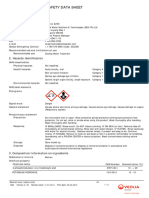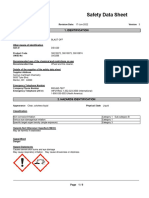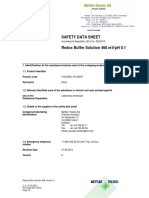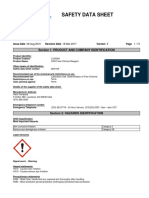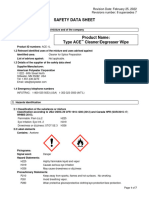Na Cse
Na Cse
Uploaded by
rezaCopyright:
Available Formats
Na Cse
Na Cse
Uploaded by
rezaOriginal Title
Copyright
Available Formats
Share this document
Did you find this document useful?
Is this content inappropriate?
Copyright:
Available Formats
Na Cse
Na Cse
Uploaded by
rezaCopyright:
Available Formats
Page 1 of 6
Modified 5/12/2017
Safety Data Sheet (SDS)
CLEAN N' SHINE Interior Cleaner & Conditioner
1. PRODUCT AND COMPANY IDENTIFICATION
1.1 Product identifiers
Product name : CLEAN N' SHINE Interior Cleaner & Conditioner
Product identifier : NA-CSE
Product Family : AQUEOUS MIXTURE
1.2 Relevant identified uses of the substance or mixture and uses advised against
Identified Uses : Automotive detailing
1.3 Details of the supplier of the safety data sheet
Company : NANOSKIN Car Care Products
Total Import Solutions, Inc.
14700 Radburn Ave.
Santa Fe Springs, CA 90670
Telephone : 562-691-6818
Fax : 562-483-8333
1.4 Emergency telephone number
Emergency phone # : PERS NORTH AMERICA 1-800-633-8253
INTERNATIONAL 1-801-629-0667
2. HAZARDS IDENTIFICATION
2.1 Classification of the substance or mixture
GHS Classification in accordance with 29 CFR 1910(OSHA HCS)
H314 Causes severe skin burns and eye damage
H318 Causes serious eye damage
Precautionary Statements
P260 Do not breathe dust/fume/gas/mist/vapors/spray
P264 Wash thoroughly after handling
P280 Wear protective gloves/protective clothing/eye protection/face protection
P301+P330+P331 If swallowed: rinse mouth. Do NOT induce vomiting
P303+P361+P353 If on skin (or hair): Take off immediately all contaminated clothing. Rinse skin with
water/shower
P304+P340 If inhaled: Remove person to fresh air and keep comfortable for breathing
P305+P351+P338 If in eyes: Rinse cautiously with water for several minutes. Remove contact lenses, if
present and easy to do. Continue rinsing
P310 Immediately call a poison center/doctor
P363 Wash contaminated clothing before reuse
P405 Store locked up
P501 Dispose of contents/container to an approved waste disposal plant.
2.2 GHS Label elements, including precautionary statements
SIGNAL WORD: DANGER
Pictogram
Page 2 of 6
Modified 5/12/2017
3. COMPOSITION/INFORMATION ON INGREDEINTS
Component CAS number Warnings Concentration
Water 7732-18-5 80 - 90
Poly(dimethylsiloxane) 63148-62-9 1-5
Siloxanes and Silicones, 68554-54-1 Skin Irrit. 2, Eye Irrit. 2 1-5
dimethyl, polymers with 3-[(2-
aminoethyl)amino]propyl
silsesquioxanes, hydroxy-
terminated
1-Dodecanamine, N,N- 1643-20-5 Skin Corr. 1B 1-5
dimethyl-, N-oxide
Sodium hydroxide 1310-73-2 Met. Corr. 1, Skin Corr. 1A, Eye Dam. 1 0.1 - 0.5
Disodium carbonate 497-19-8 0.1 - 0.5
4. FIRST AID MEASURES
First aid procedures
After inhalation:
Get victim to fresh air. Give artificial respiration or oxygen if breathing has stopped. Get
prompt medical attention. Do not give fluids if victim is unconscious. If victim is conscious, rinse mouth with water
and contact emergency number listed in section 1.4.
After contact with skin:
Immediately wash skin with soap and water. Causes skin burns. Seek immediate medical
attention if irritation or allergic reaction is present.
After contact with eyes:
Immediately flush eyes with running water for at least 15 minutes, occasionally lifting the
upper and lower eyelids. Seek immediate medical attention if redness or irritation occurs. Avoid agitation.
Abrasives present in substance may scratch eyes. Remove contact lenses if able.
After ingestion:
Rinse mouth with water, contact poison control center or emergency number listed in section 1.4. Never give
anything by mouth to an unconscious person.
Advice to doctor / Treatment:
None known.
5. FIRE FIGHTING MEASURES
Hazardous combustion products: carbon oxides
Extinguishing media: Use appropriate extinguishing media for surrounding fire.
Page 3 of 6
Modified 5/12/2017
Special fire fighting procedure: Apply alcohol-type or all purpose-type foams by manufacturers' recommended
techniques for large fires or water spray. Use carbon dioxide or dry chemical media for small fires. Use self-
contained breathing apparatus and protective equipment. Cool endangered containers with water jet.
6. ACCIDENTAL RELEASE MEASURES
Personal Precautions Use personal protective equipment. Avoid breathing vapors, mist or gas. For
personal protection see section 8.
Environmental Precautions Prevent further leakage or spillage if safe to do so. Do not let product enter
drains.
Methods for Containments
and Clean-up Contain large spills as best as possible. Dam flow with appropriate materials and
absorb centralized spillage with inert material such as vermiculite, cat litter or
diamaceous earth. Sweep and dispose of as needed. For small spills, wipe away
and wash affected area.
7. HANDLING AND STORAGE
Handling Avoid contact with skin and eyes. Avoid inhalation of vapor or mist. Wash
thoroughly after handling.
Storage Keep container tightly closed in a dry and well-ventilated place.
8. EXPOSURE CONTROLS/PERSONAL PROTECTION
Exposure Guideline Comments Exposure Limits:
Sodium hydroxide (1310-73-2)
ACGIH ACGIH Ceiling (mg/m³) 2 mg/m³
OSHA OSHA PEL (TWA) (mg/m³) 2 mg/m³
IDLH US IDLH (mg/m³) 10 mg/m³
NIOSH NIOSH REL (ceiling) (mg/m³) 2 mg/m³
Engineering Controls Adequate ventilation necessary.
Personal Protective Equipment (PPE)
Eye/Face Protection Face shield and safety glasses Use equipment for eye protection tested and
approved under appropriate government standards such as NIOSH (US) or EN
166(EU).
Skin Protection Handle with gloves. Gloves must be inspected prior to use. Use proper glove
removal technique (without touching glove's outer surface) to avoid skin
contact with this product. Dispose of contaminated gloves after use in
accordance with applicable laws and good laboratory practices. Wash and dry
hands.
Respiratory Protection None required under normal product handling conditions.
General Hygiene Considerations Wash hands before and after use and before smoking eating or drinking.
9. PHYSICAL AND CHEMICAL PROPERTIES
Physical State Liquid
Appearance White emulsion
Particle Size Not applicable
Odor Lemon
Odor Threshold No Available Data
Page 4 of 6
Modified 5/12/2017
Boiling Point 200F
Decomposition Temperature No Available Data
Melting point 32F
Relative Density 1g/cm3
Bulk Density No Available Data
Solubility in Water 100%
Solubility in other liquids No Available Data
pH 12.5
Flash point No Available Data
10. STABILITY AND REACTIVITY
Chemical Stability Stable under recommended storage conditions.
Conditions to Avoid None
Hazardous Decomposition
Products Carbon oxides
Possibility of Hazardous
Reactions None
11. TOXICOLOGICAL INFORMATION
Acute Toxicity
Not classified
Water (7732-18-5)
LD50 oral rat > 90 ml/kg
Sodium hydroxide (1310-73-2)
LD50 dermal rabbit 1350 mg/kg
ATE US (dermal) 1350 mg/kg
Poly(dimethylsiloxane) (63148-62-9)
LD50 oral rat > 24 g/kg
Disodium carbonate (497-19-8)
LD50 oral rat 4090 mg/kg
LC50 inhalation rat (mg/l) 2300 mg/m³ (Exposure time: 2 h)
ATE US (oral) 4090 mg/kg
Skin Irritation/Corrosion
Causes severe skin burns and eye damage.
Eye Irritation/Corrosion
Causes serious eye damage.
Respiratory or skin sensitization
May cause an allergic skin reaction.
Germ cell mutagenicity
Not classified.
Carcinogenicity
Not classified.
Effects of Short-Term (Acute) Exposure
Not classified.
Effects of Long-Term (Chronic) Exposure
Not classified.
Page 5 of 6
Modified 5/12/2017
Aspiration Hazard
Not classified.
12. ECOLOGICAL TOXICITY
12.1 Toxicity
Disodium carbonate (497-19-8)
LC50 fish 1 300 mg/l (Exposure time: 96 h - Species: Lepomis macrochirus [static])
EC50 Daphnia 1 265 mg/l (Exposure time: 48 h - Species: Daphnia magna)
LC50 fish 2 310 mg/l (Exposure time: 96 h - Species: Pimephales promelas [static])
Sodium hydroxide (1310-73-2)
LC50 fish 1 45.4 mg/l (Exposure time: 96 h - Species: Oncorhynchus mykiss [static])
12.2 Persistence and degradability
No data available
12.3 Bioaccumulative potential
Disodium carbonate (497-19-8)
BCF fish 1 (no bioaccumulation)
12.4 Mobility in soil
No data available
12.5 Results of PBT and vPvB assessment PBT/vPvB assessment not available as chemical safety assessment
not required/not conducted
12.6 Other adverse effects
No data available
13. DISPOSAL CONSIDERATIONS
Dispose of in accordance with federal, provincial and local government regulations. Containers should NOT be re-
used. Containers should be disposed of in accordance with government guidelines.
14. TRANSPORT INFORMATION
Shipping Information
Not UN rated.
Special Shipping Information
Not applicable.
NFPA/HMIS
2 HEALTH
0 FLAMMABILITY
0 REACTIVITY
15. REGULATORY INFORMATION
US Federal
Water (7732-18-5)
Listed on the United States TSCA (Toxic Substances Control Act) inventory
1-Dodecanamine, N,N-dimethyl-, N-oxide (1643-20-5)
Listed on the United States TSCA (Toxic Substances Control Act) inventory
Disodium carbonate (497-19-8)
Listed on the United States TSCA (Toxic Substances Control Act) inventory
Page 6 of 6
Modified 5/12/2017
Siloxanes and Silicones, dimethyl, polymers with 3-[(2-aminoethyl)amino]propyl silsesquioxanes, hydroxy-terminated (68554-54-1)
Listed on the United States TSCA (Toxic Substances Control Act) inventory
EPA TSCA Regulatory Flag XU - XU - indicates a substance exempt from reporting under the Inventory Update Reporting
Rule, i.e, Partial Updating of the TSCA Inventory Data Base Production and Site Reports (40
CFR 710(C)).
Sodium hydroxide (1310-73-2)
Listed on the United States TSCA (Toxic Substances Control Act) inventory
CERCLA RQ 1000 lb
Poly(dimethylsiloxane) (63148-62-9)
Listed on the United States TSCA (Toxic Substances Control Act) inventory
EPA TSCA Regulatory Flag XU - XU - indicates a substance exempt from reporting under the Inventory Update Reporting
Rule, i.e, Partial Updating of the TSCA Inventory Data Base Production and Site Reports (40
CFR 710(C)).
US State
Sodium hydroxide (1310-73-2)
U.S. - Massachusetts - Right To Know List
U.S. - Minnesota - Hazardous Substance List
U.S. - New Jersey - Right to Know Hazardous Substance List
U.S. - Pennsylvania - RTK (Right to Know) List
16. OTHER INFORMATION
SDS Prepared by Total Import Solutions, Inc. dba NANOSKIN Car Care Products
Disclaimer This health and safety information is correct to the best of our knowledge and
belief at the date of its publication, but we cannot accept liability for any loss,
injury or damage which may result from its use. We shall ensure, so far as is
reasonably practicable, to maintain revised copies of this information to be
requested. When applicable, revised copies shall be sent to customers whom
have been directly supplied with this substance. It must be known that it is the
responsibility of any intermediate supplier to ensure that such revision is passed
to the user. The information given in the Data Sheet is designed only as
guidance for safe handling, storage and the use of the substance. It is not a
specification nor does it guarantee any specific properties. All chemicals should
be handled only be competent personnel, within a controlled environment.
Should further information be required, this can be obtained through the sales
office whose address is at the top of this sheet.
You might also like
- 30.MSDS Hydrex 2250 SG - GHSDocument6 pages30.MSDS Hydrex 2250 SG - GHSPrabath VlogsNo ratings yet
- Cullex Resin MSDSDocument6 pagesCullex Resin MSDSJuan ArcosNo ratings yet
- L4 Writing Candy's Shopping TripDocument2 pagesL4 Writing Candy's Shopping Tripsarasvathy_krishnamo75% (4)
- Strategy Formulation Integrating The CorporationDocument8 pagesStrategy Formulation Integrating The CorporationRLDNo ratings yet
- Top 100 Aerospace & Defence CompaniesDocument14 pagesTop 100 Aerospace & Defence Companieschintanvisharia40% (5)
- Safety Data Sheet (SDS) : NANOSKIN RAIN PREP Glass Activator & CleanerDocument5 pagesSafety Data Sheet (SDS) : NANOSKIN RAIN PREP Glass Activator & CleanerKinukaNo ratings yet
- Cherry Suds NanoskinDocument5 pagesCherry Suds Nanoskinttorreznvidia.comNo ratings yet
- SDS Na-WetDocument5 pagesSDS Na-WetrezaNo ratings yet
- Safety Data Sheet: 1. Identification of The Substance/Preparation and of The Company/UndertakingDocument8 pagesSafety Data Sheet: 1. Identification of The Substance/Preparation and of The Company/UndertakingRinaldi SatriaNo ratings yet
- Hs Liquido Alcalino Acc Ex AceDocument8 pagesHs Liquido Alcalino Acc Ex AceLennynRafaelSaldañaCabreraNo ratings yet
- Advocate Cat and Dog SDS 122000001555 Sept19Document14 pagesAdvocate Cat and Dog SDS 122000001555 Sept19NeySha Poe (Sha)No ratings yet
- Blast OffDocument9 pagesBlast OffMohamed HassanNo ratings yet
- General Purpose BleachDocument5 pagesGeneral Purpose BleachAnthoney MooreNo ratings yet
- Ptei Estocure P - Sds - 190405Document5 pagesPtei Estocure P - Sds - 190405Denis nataliaNo ratings yet
- MSDS Dynamic DescalerDocument4 pagesMSDS Dynamic DescalerEurotech Tra TranNo ratings yet
- MSDS PermaClean PC-33Document10 pagesMSDS PermaClean PC-33evgdamNo ratings yet
- MSDS Kaigo Tyer CoolantDocument4 pagesMSDS Kaigo Tyer CoolantJhonAceMalauNo ratings yet
- Redox Buffer Solution 468 MV - PH 0.1 - enDocument9 pagesRedox Buffer Solution 468 MV - PH 0.1 - enEnrique FrancoNo ratings yet
- MSDS - XA30582 - GB - AD STENCIL REMOVER CONC. - 2022 - ENGDocument8 pagesMSDS - XA30582 - GB - AD STENCIL REMOVER CONC. - 2022 - ENGLê Công VõNo ratings yet
- 402Q80-1 MSDSDocument7 pages402Q80-1 MSDSMario Torres BeltranNo ratings yet
- MSDS - JAX - Food - Grade - Penetrating - Oil - Aerosol - SDS - 020717Document5 pagesMSDS - JAX - Food - Grade - Penetrating - Oil - Aerosol - SDS - 020717Mohamad HudhaNo ratings yet
- Safety Data Sheet: Section 1: Product and Company IdentificationDocument15 pagesSafety Data Sheet: Section 1: Product and Company IdentificationrbozaNo ratings yet
- Neo Heliopan Hydro Phenylbenzimidazole Sulfonic Acid Enuzizole All DocumentsDocument17 pagesNeo Heliopan Hydro Phenylbenzimidazole Sulfonic Acid Enuzizole All DocumentsrigolotNo ratings yet
- Safety Data Sheet: 1. Identification of The Substance/Preparation and of The Company/UndertakingDocument8 pagesSafety Data Sheet: 1. Identification of The Substance/Preparation and of The Company/UndertakingeadriesNo ratings yet
- Safety Data Sheet: DLS 970ADocument8 pagesSafety Data Sheet: DLS 970AswasanaNo ratings yet
- Eng GacDocument7 pagesEng GacEr Jyotirmaya DalaiNo ratings yet
- FT FoamDocument10 pagesFT FoamaraceliNo ratings yet
- SDS-Flake Phthalic Anhydride of Contitnental Petrochemicals (Thailand) Co.,Ltd.Document6 pagesSDS-Flake Phthalic Anhydride of Contitnental Petrochemicals (Thailand) Co.,Ltd.Muslim NasirNo ratings yet
- IXOM Caustic Soda Pearls MSDSDocument7 pagesIXOM Caustic Soda Pearls MSDSStariunNo ratings yet
- Safety Data Sheet: Section 1. IdentificationDocument11 pagesSafety Data Sheet: Section 1. IdentificationPatrick Michael PerezNo ratings yet
- Carbofen SDSDocument8 pagesCarbofen SDSsalaupanNo ratings yet
- Econ 60Document15 pagesEcon 60fivade5459No ratings yet
- Safety Data Sheet: ARDROX 907PB AerosolDocument11 pagesSafety Data Sheet: ARDROX 907PB Aerosolabdulbaset alselwi100% (1)
- Timken Gr183 Sds India Ghs Eu EnglishDocument6 pagesTimken Gr183 Sds India Ghs Eu EnglishGowthamNo ratings yet
- MSDS en 3767Document7 pagesMSDS en 3767Kiên PhùngNo ratings yet
- Cherry Blast HD Hand Soap PDFDocument7 pagesCherry Blast HD Hand Soap PDFGregorio Antonio Valero VerdeNo ratings yet
- Buffer Solution PH 11.00Document9 pagesBuffer Solution PH 11.00qavictoriacareNo ratings yet
- Usa Safety Data Sheet: LORD Corporation 111 LORD Drive Cary, NC 27511-7923 USADocument6 pagesUsa Safety Data Sheet: LORD Corporation 111 LORD Drive Cary, NC 27511-7923 USALaura RodríguezNo ratings yet
- PEROXIDE MULTI SURFACE CLEANER EnglishDocument10 pagesPEROXIDE MULTI SURFACE CLEANER Englishsatya ranjanNo ratings yet
- MSDS ZepDocument11 pagesMSDS ZepMedio AmbienteNo ratings yet
- SDS NITOFLOR SL1000 IndiaDocument29 pagesSDS NITOFLOR SL1000 IndiaMaha MuflehNo ratings yet
- Multigrade Paper Developer US G17!1!10002Document9 pagesMultigrade Paper Developer US G17!1!10002Michelle SilberbergNo ratings yet
- Bendix High Performance Heavy Duty Dot4 Brake Fluid SDS 2019Document7 pagesBendix High Performance Heavy Duty Dot4 Brake Fluid SDS 2019indriyanii741No ratings yet
- SDS BlueRaspberryFragrantOilDocument5 pagesSDS BlueRaspberryFragrantOilFayez DownseekerNo ratings yet
- Safety Data Sheet: Section 1: Identification of The Product and CompanyDocument7 pagesSafety Data Sheet: Section 1: Identification of The Product and CompanyFuckyouNo ratings yet
- M105564Document4 pagesM105564amine.essaki8No ratings yet
- Safety Data Sheet: Metalcrete IndustriesDocument4 pagesSafety Data Sheet: Metalcrete IndustriesCarlos Alberto Luyo BuendíaNo ratings yet
- SP179 Hand SanitiserDocument7 pagesSP179 Hand SanitiserJohn GeddesNo ratings yet
- 000534hy Aghs enDocument14 pages000534hy Aghs enCarlos MillaNo ratings yet
- Safety Data Sheet Aquafin-Ic Admix-PowderDocument5 pagesSafety Data Sheet Aquafin-Ic Admix-PowderJitendra ShahNo ratings yet
- Clorox Lavender BleachDocument10 pagesClorox Lavender BleachJeff MNo ratings yet
- Chemical Inventory Template PDFDocument10 pagesChemical Inventory Template PDFনিঃসঙ্গ হিমুNo ratings yet
- Resolve 8Document5 pagesResolve 8Isaac MartinezNo ratings yet
- Cocamide Dea MsdsDocument6 pagesCocamide Dea Msdsmaha muhammedNo ratings yet
- ACE SDS NAM En-1Document7 pagesACE SDS NAM En-1chem6251933No ratings yet
- Popular Science The Big Book of HacksDocument5 pagesPopular Science The Big Book of HackssriramNo ratings yet
- HDS ZycobondDocument10 pagesHDS ZycobondCatalina AstudilloNo ratings yet
- Hoja Seguridad Aceite f150 Diesel Oil Sae 10w 30Document6 pagesHoja Seguridad Aceite f150 Diesel Oil Sae 10w 30Baruch CamposNo ratings yet
- Kay 5 Sanitizer 520151SDSDocument8 pagesKay 5 Sanitizer 520151SDSraNo ratings yet
- Metalset A-4Document16 pagesMetalset A-4edgar.sanchez.urreaNo ratings yet
- SDS Sodium PhosphateDocument7 pagesSDS Sodium PhosphateXINLEI SUNNo ratings yet
- MSDS Yeser® EDTA 2na Rev.Document8 pagesMSDS Yeser® EDTA 2na Rev.Adiba Naura ShakilaNo ratings yet
- Optigal’s Q & A for the CLRE: Contact Lens Registry Exam Questions Basic Certification - NCLEFrom EverandOptigal’s Q & A for the CLRE: Contact Lens Registry Exam Questions Basic Certification - NCLENo ratings yet
- ColaTeric COAB TDSDocument1 pageColaTeric COAB TDSrezaNo ratings yet
- 2023 95 Rci Foaming Face Wash 160nc Lhs PSGC CaDocument1 page2023 95 Rci Foaming Face Wash 160nc Lhs PSGC CarezaNo ratings yet
- COS1603 - 16CarliMultiمواد چند منظورفرمول های برندهDocument4 pagesCOS1603 - 16CarliMultiمواد چند منظورفرمول های برندهrezaNo ratings yet
- Car Wash and Wax HCAC08Document1 pageCar Wash and Wax HCAC08rezaNo ratings yet
- Cos1710 Iff 01Document1 pageCos1710 Iff 01rezaNo ratings yet
- Cos1911 ZschimmerDocument1 pageCos1911 ZschimmerrezaNo ratings yet
- 4030 Soothing Odor Control Wipes Sme Lipid C d9Document1 page4030 Soothing Odor Control Wipes Sme Lipid C d9rezaNo ratings yet
- COS2003 CrodaDocument2 pagesCOS2003 CrodarezaNo ratings yet
- 4005 Waterless Hand Cleaner Soy Methyl EsterDocument1 page4005 Waterless Hand Cleaner Soy Methyl EsterrezaNo ratings yet
- Bisley-Phosphonate-Dispersant-Plasticizer-TDS (1) پخش کننده و روان کننده فسفونات بیسلیDocument2 pagesBisley-Phosphonate-Dispersant-Plasticizer-TDS (1) پخش کننده و روان کننده فسفونات بیسلیrezaNo ratings yet
- SPF HIS All-In-One Handpolish For High Gloss and Slip CAR-4056 USDocument2 pagesSPF HIS All-In-One Handpolish For High Gloss and Slip CAR-4056 USreza100% (1)
- کارواش - نوع تونلیDocument1 pageکارواش - نوع تونلیrezaNo ratings yet
- کنسانتره شستشوی ماشین مصرفی با جایگزینDocument2 pagesکنسانتره شستشوی ماشین مصرفی با جایگزینrezaNo ratings yet
- Plastyn-SP-USA-SDS-Issued-11062020ملامین سولفوناتDocument9 pagesPlastyn-SP-USA-SDS-Issued-11062020ملامین سولفوناتrezaNo ratings yet
- Bisflow S100M1 TDSاطلاعات محصولDocument2 pagesBisflow S100M1 TDSاطلاعات محصولrezaNo ratings yet
- چربی زدای همه منظوره مشتق شده طبیعیDocument2 pagesچربی زدای همه منظوره مشتق شده طبیعیrezaNo ratings yet
- Surface Chemistry Fabric and Cleaning TiDocument1 pageSurface Chemistry Fabric and Cleaning TirezaNo ratings yet
- TOUCHLESS VEHICLE WASH W NATSURF 265 HCAC20v1Document1 pageTOUCHLESS VEHICLE WASH W NATSURF 265 HCAC20v1rezaNo ratings yet
- Ironing Spray HCLF15Document1 pageIroning Spray HCLF15rezaNo ratings yet
- خمیر ظرفشوییDocument1 pageخمیر ظرفشوییrezaNo ratings yet
- فرش پاک کنDocument2 pagesفرش پاک کنrezaNo ratings yet
- Biodegradable Detergents From Azadirachta Indica (Neem) Seed OilDocument7 pagesBiodegradable Detergents From Azadirachta Indica (Neem) Seed OilrezaNo ratings yet
- HCLF35 Liquid Laundry Detergent With Odour Neutraliserشوینده مایع لباسشویی با خنثی کننده بوDocument1 pageHCLF35 Liquid Laundry Detergent With Odour Neutraliserشوینده مایع لباسشویی با خنثی کننده بوrezaNo ratings yet
- Conditioner BarDocument1 pageConditioner BarrezaNo ratings yet
- Automotive Wheel or Tire CleanerDocument1 pageAutomotive Wheel or Tire CleanerrezaNo ratings yet
- ECO Brij L6L Liquid Laundry Detergent For Modern StainsDocument1 pageECO Brij L6L Liquid Laundry Detergent For Modern StainsrezaNo ratings yet
- Kashyap Enterprises Silicone Polish FormulationDocument2 pagesKashyap Enterprises Silicone Polish FormulationrezaNo ratings yet
- Area Related To CirclesDocument3 pagesArea Related To CirclesPratham JainNo ratings yet
- Bài tập đảo ngữDocument5 pagesBài tập đảo ngữPhạm Đức HiệpNo ratings yet
- Polyarteritis NodosaDocument10 pagesPolyarteritis Nodosaaaron mbindyoNo ratings yet
- Project Assignment HRMDocument19 pagesProject Assignment HRMjtopuNo ratings yet
- TLE10 Q3 Lesson1Document19 pagesTLE10 Q3 Lesson1Ella Cagadas PuzonNo ratings yet
- Alvin A. Arens, Randal J. Elder, Mark S. Beasley, Chris E. Hogan - Auditing and Assurance Services-Pearson (2016) - 66-82Document17 pagesAlvin A. Arens, Randal J. Elder, Mark S. Beasley, Chris E. Hogan - Auditing and Assurance Services-Pearson (2016) - 66-82kwm2wv6s7wNo ratings yet
- Henry FieldingDocument12 pagesHenry FieldingMary Rose BaluranNo ratings yet
- Jesus Bleibet Meine Freude Johann Sebastian BachDocument3 pagesJesus Bleibet Meine Freude Johann Sebastian BachgabibeuscherNo ratings yet
- Read The Text. Taylor SwiftDocument2 pagesRead The Text. Taylor Swiftfajar sukmanaNo ratings yet
- Medical ImagingDocument12 pagesMedical ImagingKeanan WongsoNo ratings yet
- PP StoryboardDocument1 pagePP StoryboardAnn SoonNo ratings yet
- Tests' Schedule For 2019 - 21 Engineering Batches: MAJOR TEST: Main & Advanced (Offline)Document1 pageTests' Schedule For 2019 - 21 Engineering Batches: MAJOR TEST: Main & Advanced (Offline)Uma JadounNo ratings yet
- 07-09-14 EditionDocument28 pages07-09-14 EditionSan Mateo Daily JournalNo ratings yet
- Senatel Pulsar - TDS - en - 2019-04-12 - SpainDocument3 pagesSenatel Pulsar - TDS - en - 2019-04-12 - Spainxiping dingNo ratings yet
- Adult Health Nursing II Laboratory Course Syllabus 2020-2021Document52 pagesAdult Health Nursing II Laboratory Course Syllabus 2020-2021Hajer Alowaisi100% (1)
- MSU-TCTO Vision and Mission: A Research University Renowned For Fisheries, Marine and Environmental ScienceDocument5 pagesMSU-TCTO Vision and Mission: A Research University Renowned For Fisheries, Marine and Environmental ScienceMhdv Ndn McmNo ratings yet
- EUROLAB Cook Book - Doc No 18 Risk Based Appraoch - Rev. 2017Document5 pagesEUROLAB Cook Book - Doc No 18 Risk Based Appraoch - Rev. 2017Anonymous Z7Lx7q0Rz100% (1)
- Promoting Non-ViolenceDocument5 pagesPromoting Non-ViolenceNicko BasesNo ratings yet
- Wildcat Family Network XXS: Important Dates Parent University SymposiumDocument3 pagesWildcat Family Network XXS: Important Dates Parent University SymposiumRicardo RecinosNo ratings yet
- Introduction To ICT-Chapter 4 ExerciseDocument2 pagesIntroduction To ICT-Chapter 4 ExerciseputrialyaaNo ratings yet
- Cy Twombly - Photographs Volume II CatalogueDocument3 pagesCy Twombly - Photographs Volume II CatalogueArtdataNo ratings yet
- Water Level & Rainfall 2024 1717908056Document2 pagesWater Level & Rainfall 2024 1717908056ALAM ENGINEERINGNo ratings yet
- Toefl Structure and Written Expression Practice Test 01Document2 pagesToefl Structure and Written Expression Practice Test 01Laiyinatus SyiFa Z NNo ratings yet
- Oxford LinksDocument2 pagesOxford LinksLuis Henrique Pereira0% (2)
- BibliographyDocument3 pagesBibliographyapi-499574870No ratings yet
- Falcon Freight LINK PVT - LTD Custom House AgentDocument24 pagesFalcon Freight LINK PVT - LTD Custom House AgentfalconNo ratings yet
- Computer Board Project 2017 (Icse)Document25 pagesComputer Board Project 2017 (Icse)Sayak77% (196)
